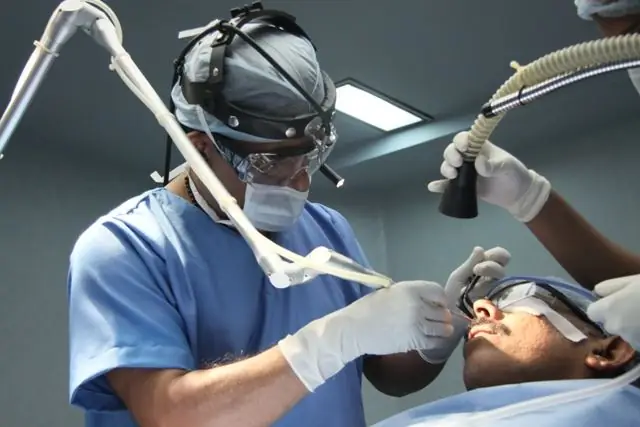- Author Curtis Blomfield [email protected].
- Public 2023-12-16 20:44.
- Last modified 2025-01-23 17:01.
Everyone has experienced the common cold. However, in some cases, thick mucus comes out of the nose instead of liquid. There is a feeling that the nose is clogged, it is not possible to blow your nose normally. Atrophic rhinitis is an inflammatory pathology of the nasal mucosa, characterized by a number of sclerotic changes. The most obvious symptom: painful drying of the nasal mucosa, the appearance of scabs and bleeding.

Causes of pathology
An experienced otolaryngologist will be able to determine the correct cause of atrophic rhinitis based on a thorough examination and test results of the patient. Pathological sources include fungal cultures or bacteria. In addition, a dry runny nose can be genetic. In some cases, atrophic rhinitis is formed due to:
- Imbalance of hormones, especially endocrine disorders that occur in the human body during puberty.
- Surgical interventions, especially in operations to correct the nasal septum and change its shape.
- With deficiency of iron and vitamin D in the human body.
Symptoms of atrophic rhinitis in adults in an acute form may appear due to the penetration of chemicals into the nasal passages in high concentrations or after sudden climatic changes.
Essence and types of atrophic rhinitis
The concept of "atrophy" implies a pathological condition, accompanied by a strong thinning of the skin, mucous membranes and organs, which can be located in different parts of the body.

Atrophic rhinitis is an inflammatory chronic disease that affects the nasal mucosa and leads to its thinning. In the course of the development of the disease, the functional state of other structures localized in the mucous membrane is also disturbed. These include: sensitive endings of the nerves that are responsible for smell, microcirculatory vessels, glands that produce mucus that protects the nasal cavity from drying out. Also, in some cases, pathology can affect bone and cartilage tissues.
Depending on the causes and characteristics of development, there are two main types of chronic atrophic rhinitis:
- primary, which is characterized by the development of thinning of the nasal mucosa and all the structures that make up its composition, after which the process of inflammation is added to them;
- secondary rhinitis, the development of which is the opposite: prolongedinflammation, which occurred due to various reasons, atrophies the mucosa.
The primary form has such a name as ozena, that is, a fetid runny nose. The disease always accompanies the appearance of putrefactive processes, an unpleasant odor is felt when breathing. If it remains for a long time, the center of the brain responsible for smell "gets used" to such a state and no longer notices it. However, people around you will always smell it.
Disease symptoms

Atrophic rhinitis has rather specific symptoms, so the disease is difficult to confuse with other pathological processes in the nasal cavity. The patient may feel anxious due to abnormalities such as:
- sudden lightening of the nasal mucosa;
- appearance of dry green-yellow crusts in the nose;
- dry feeling in sinus passages;
- clots of mucus are excreted with blood.
Bad smell
If the symptoms of atrophic rhinitis are ignored for a long time, a strong unpleasant odor from the nose may appear (especially if the cause is a bacterial infection). In especially neglected situations, significant deformations of the nose may appear. Also, the necrotic process is able to spread to the membranes surrounding the brain. In the vast majority of cases, this form of rhinitis is not life-threatening, but less than 1% of patients died from this disease. So, what to do with the symptoms of atrophic rhinitis?
Diagnostic methods
Engaged in the diagnosis and further treatment of such rhinitis is an ENT doctor, that is, an otolaryngologist. The primary conclusion is made on the basis of typical clinical symptoms. In addition, after determining the specifics of the manifestation of the disease, a differential diagnosis of atrophic rhinitis (primary and secondary) is carried out.
To determine the severity of the transformation of the mucous membrane, which includes its thinning, rhinoscopy is performed, which refers to instrumental diagnostic methods, through which the specialist gives a visual assessment of the condition of the walls of the nasal passages.

Identifying the cause
The cause of the onset of the disease is determined using a laboratory study, which involves the sowing of biomaterial, that is, a swab from the nasal mucosa on special nutrient media.
In the presence of bacteria, colonies of microorganisms grow on them, which are then identified by antigenic, biochemical and morphological features. In addition, thanks to the study, it is possible to identify the sensitivity of these microorganisms to certain antibiotics. Based on all diagnostic results, the specialist will prescribe the appropriate therapeutic regimen.
Treatment of atrophic rhinitis

Currently existing therapeutic methods are conventionally divided into conservative and surgical. Therapy begins with the constant use of glycerin drops and washing the sinuses with salinelow concentration solution. What else does the treatment of atrophic rhinitis in adults involve? Here are the ways of therapy:
- Flushing. The drugs used will not be able to cope with the multiplication of bacteria and will not eliminate the real pathogenic source. The nose can be treated with a solution of hydrogen peroxide at a concentration of 3%. The procedure is quite simple: the patient needs to tilt his head to the side and slightly open his mouth. Through a syringe or pipette, 25-50 milliliters of liquid is injected into each nostril. In this case, care must be taken that the solution could not get into the throat. Treatment of atrophic rhinitis is best done under medical supervision.
- Inhalation. Those who love alternative treatment can do inhalations based on fresh garlic (a few cloves are simply ground into gruel and then poured with a small amount of boiling water). This method can help the patient because garlic has strong antibacterial properties.
- Tamponade. In addition, you can moisten a sterile cotton swab with glycerin and iodine solution (2%), place it in one of the nostrils and keep it there for two to three hours. Crusts will also come out of the sinuses along with the swab. After two or three procedures, the disappearance of an unpleasant odor during breathing becomes noticeable. What drugs are suitable for the treatment of atrophic rhinitis?
- Antibiotics. If treatment with home remedies fails, antibiotic therapy is required. The choice of topical or oral medications depends on what the true cause of the disease is. But you can't use antibiotics on your own. Thereinin the case when rhinitis is provoked by beriberi or hormonal failure, drugs only aggravate the situation. The otolaryngologist will prescribe aggressive agents only after receiving test results that confirm the presence of gram-negative or gram-positive bacteria.
Atrophic rhinitis in adults can also be treated with surgery.

Surgery
Surgical treatment of the nasal structures is usually required in the absence of the effect of conservative methods or in the presence of anatomical abnormalities (curvature of the septum) that atrophy the mucosa.
Modern surgical therapy includes minimally invasive techniques that improve metabolic processes with cellular restoration (laser therapy). If the thinning is pronounced, then implantation is carried out, including the implantation of one's cartilage tissue, which is taken from other parts of the body, for example, from the maxillary sinuses.
Only an ENT doctor can make a decision about the method of treating atrophic rhinitis and prophylaxis, based on the diagnostic measures taken. Since the symptoms can be temporarily eliminated in case of illness, independent actions when choosing drugs are not recommended.

Preventive measures
To prevent or improve the results obtained with conservative treatment, you can put a special humidifier in your apartment.
WhenIf you have atrophic rhinitis, rinse your nose with a saline solution and use glycerin-based tamponade during the hot months with minimal humidity.
It is allowed to use cotton swabs to lubricate the nostrils with sea buckthorn oil. If the disease develops into a chronic one, patients living in dry climates should consider moving to an area of the country with higher humidity.






